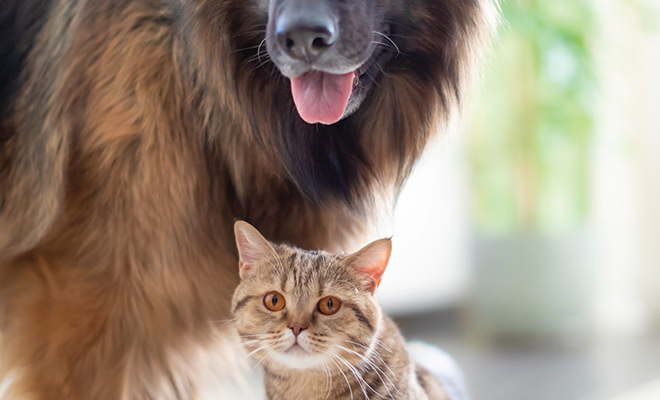
Blending Your Four-Legged Family
More than 1,000 new stepfamilies are formed every day. Statistics show that more than half of families in the U.S. have been created through remarrying or re-coupling.
This results in the blending of families and the merging of two established households to create one brand-new domestic situation. During these important and sometimes stressful life changes, the focus for a positive transition typically is directed at the two-legged members of the family. But often this melding of households comes with another set of issues to consider: the well-being of the pets. Unfortunately, parents of four-legged, feathered, finned or scaly pet kids sometimes forget to take the steps needed to make this new unity work seamlessly for all.
Humans may love each other unconditionally, but they still struggle to accept the addition of a new family member that goes to the bathroom outside, eats from a bowl on the floor or chirps in the middle of the night. Even if the new significant other is a pet lover, forming a new relationship with a pet they aren’t comfortable with can be tense and trying. Other issues can arise if both parties are pet owners and the new step-cat or step-dog doesn’t see eye to eye with these new living arrangements. Just as newly unified families need to work together to create a harmonious life, they should direct the same effort toward the care, comfort and safety of the pets that are thrown into an unfamiliar situation.
Create a safe haven
Kids appreciate items that feel like home, such as blankets and toys, when adjusting to a new environment; pets do as well. Make sure Fido’s favorite dog bed or Kitty’s special pillow makes the move with them so they can enjoy those familiar comfort objects in their new home. Make a pet crate or cage accessible to them so they have a familiar place to retreat to. As their confidence and comfort level grow, these familiar items will become less important and merging into the family will be less tense.
Make the introduction slowly
Imagine how traumatic it would be for humans if one day suddenly everything in our world was brand new. Now imagine this from a pet’s perspective. Strange smells and sights can stress pets out and create bigger issues. Make the introduction to their new surroundings a slow process and take it one step at a time. If you’re blending multiple pets together, start with a brief introduction on neutral ground. An hour is sufficient time for the first few meetings and pet owners should cut the initial meeting short while everyone is still happy and calm. After a few successful sessions, pet owners can then introduce the new home or apartment to the incoming pet.
Watch for signals
When blending step-cats and step-dogs, pet owners need to pay attention to their animals’ body language. When dogs meet cats, they tend to respond in one of three ways: play, prey or cautious avoidance. Kitty, however, may not share in the enthusiasm when the new intruder in her life thinks its playtime. Cats transition better when they have a quiet place to retreat to and have an area up high where they can feel safe. When new dogs meet each other, common behaviors are to sniff each other and investigate. During this initial introduction, pet owners should pay attention to both dogs’ body language. If ears are down or back, that is an indication of anxiety, fear or aggression. Tails are signals of how the well the meeting is going. If tails are up, it’s a signal of confidence and interest. If tails are between the legs, it’s a sign of fear and apprehension. Watch the signals and act accordingly.
Understand everyone’s need to adjust
In instances of blending animals and humans together in a new setting, all parties involved must understand that the new union will not always be smoothing sailing. Moving is difficult for most pets; each one will respond differently to a new home full of strange sights, unfamiliar human(s) and especially a new furry roommate. Most partner disagreements over pets come down to tolerance levels, and families need to remember to work together on fixing pet behaviors. Dogs or cats who are not used to socializing may take longer to acclimate, but by being empathetic to everyone’s needs and feelings, families can be part of the solution, not part of the problem.
As with any relationship, there may be times when experts need to be called in. If blood has been drawn or families are struggling to co-exist, take steps to restore calm in this new blended household. Merging pets usually has a happy ending, but it can take time, patience and communication among everyone involved.
Sources: deseretnews.com and stepfamily.org.







